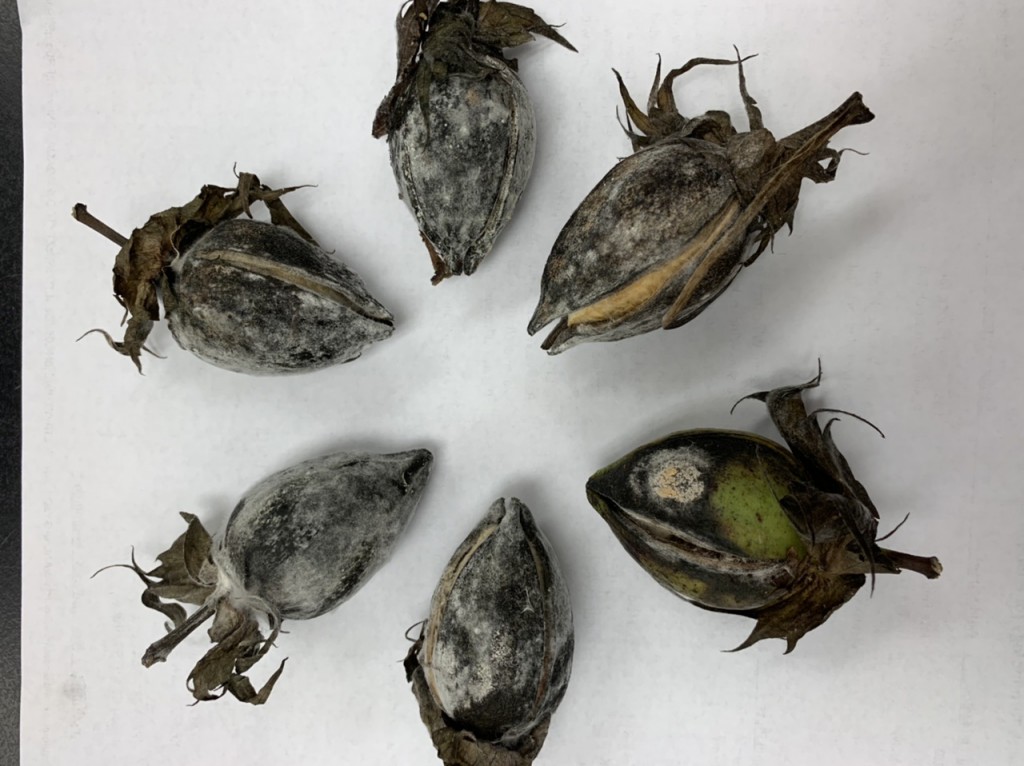By Bob Kemerait
Peanut Rust has been found in multiple counties over the past week. Point: many peanut growers STILL have 2 (or more) fungicide applications to go and they should (at least in SW District) factor PREVENTATIVE management of peanut rust in the equation.
From Dr. Albert Culbreath:
A few thoughts. I have little data on what works (for control of peanut rust), mostly some experience with what doesn’t.
From others as well as my observations, I agree that growers should not count on rust control from Miravis. I believe if it is mixed with Elatus, it should be ok for rust control, but I do not know whether Elatus would provide rust control for an extended period of time. I would not expect it to. I think Provost Silver would do well. I don’t know about Priaxor or Revysol (as we have not tested them). I just don’t have experience with that. Alto, in the past has held up well against rust. However, Alto I believe has a 30 day PHI, so it would be out for quite a few fields already. Chlorothalonil is active against rust, but is purely protectant. Control of rust with chlorothalonil may require a shorter application window. Growers who like to end up their season with Topsin should not rely on that fungicide alone for rust control, mixtures with full rates of tebuconazole or chlorothalonil should help with rust. I believe both tebuconazole and chlorothalonil have 14 day PHIs, I’ll see what else I might think of. Miravis and Topsin would be two to stay away from unless mixed with something that does control rust. I don’t know about Flutriafol on rust. I know it’s active on other rusts… but that don’t mean much. Hope this helps.
Albert
More cotton boll rots showing up. More and more of what Jason Brock and I are seeing seems to be Colletotrichum boll rot. The seeming sudden appearance has some asking (understandably) if this is something “new and extraordinary”. You may even get pushed hard on an answer to that. Listen to me. Take a deep breath. Colletotrichum and Diplodia boll rots are not new. Below is a photo of Collectotrichum boll rot.

They are all-too-common in our hot and humid Georgia climate. I agree we are seeing more than I expected at this time, but given the excellent growth of much of our cotton, high humidity, and now more rain, it is an unfortunate part of growing cotton. Given the rains some of you received Monday, boll rot could get real ugly.
With reports of the last couple weeks of areolate mildew in cotton in Screven and Colquitt Counties, the last of the familiar “bad guys” are active in our commercial fields somewhere in Georgia. These include Tomato spotted wilt, nematodes, white mold and leaf spot on peanut, areolate mildew, target spot, Stemphylium leaf spot, bacterial blight, Fusarium wilt, and nematodes on cotton, Asian soybean rust, Cercospora leaf blight, charcoal rot, and anthracnose on soybeans, and nematodes, blights and southern rust on corn.
The hot, humid conditions with better-than-ever chances of rainfall for many of you create near-perfect conditions for development and spread of disease.
At this point, I believe the most urgent threat is from white mold and leaf spot to the peanut crop. Cotton growers should watch for areolate mildew and target spot where fungicides could be effective- growers should refine the decision process by considering 1) crop potential, 2) time left until harvest, 3) amount of Disease already in the field, 4) time since last fungicide application, and 5) weather conditions.
For things like Tomato spotted wilt, nematodes, Stemphylium leaf spot, charcoal rot, etc. for which there is no remedy at this point in the season, growers should consider what they can do differently in 2021.
Aug 21st Morning Greetings- please follow updates from Pam Knox regarding the projections for the upcoming storms. Recognizing that there is likely a good chance the storm will affect us early next week, peanut growers should consider timely fungicide applications ahead of the storm. Also, they should recognize that conditions are, and will continue to be, very very favorable for development and spread of white mold, leaf spot, and now peanut rust. Be prepared.
Dr. Ed Sikora, my esteemed colleague at Auburn, conducted a survey across northern Alabama over the past few days and confirmed soybean rust has spread over much of the state. This is further warning to soybean producers across all of Georgia to pay careful attention to soybean rust. Certainly, ALL soybean producers on the Coastal Plain of GA (SW and SE Districts) are strongly advised to consider use of fungicides if not yet at full seed.
Aug 21 Afternoon Greetings: Please note comments from Dr. Albert Culbreath regarding our rust/leaf spot situation today, given the weather we are expecting as well. Also note that areolate mildew continues to be found in more cotton fields across the Coastal Plain (Ben Reaves found it well-established in a field in Berrien County today). While the fields have been scattered, I believe areolate mildew will quickly spread over the coming week. Admittedly, we have limited efficacy data, but what we have (including that from Jeremy Kichler in Colquitt and Stephanie Hollifield in Brooks) shows that timely fungicide applications can protect yield IF 1) you are further than 4 weeks from defoliation, 2) you have good yield potential, 3) the disease has not advanced too far, and 4) weather conditions are favorable for spread (they are). Because of limited data, I am uncomfortable being too exact in what to expect from areolate mildew, but I have seen enough to know that prudent use of fungicides can be justified.
Thanks
Bob